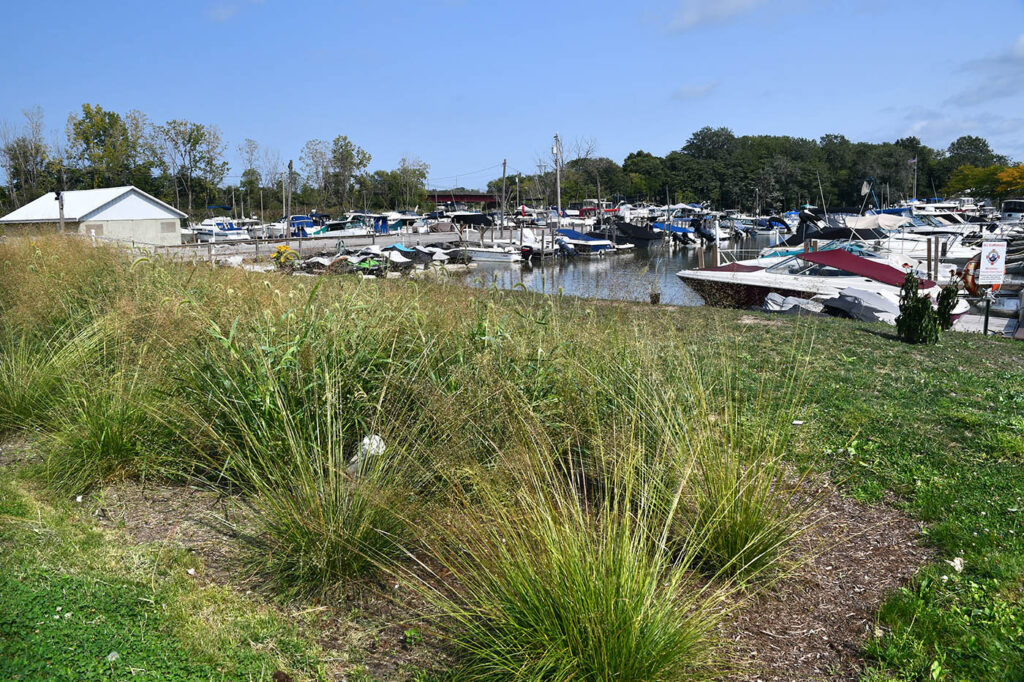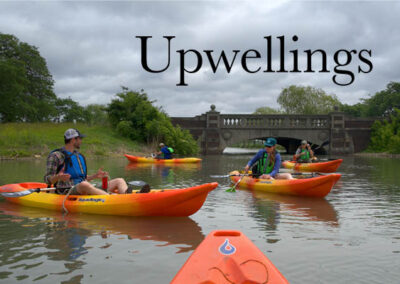
A recently completed project is helping marinas in the Great Lakes region become more sustainable and resilient through use of green infrastructure. The primary goal of this project, Advancing Stormwater Management at Marinas in the Great Lakes, was to expand implementation of onsite stormwater management at marinas in the Great Lakes region. The project team, including staff from Michigan Sea Grant, Wisconsin Sea Grant, and Ohio Sea Grant, worked with marinas in their three states to demonstrate how these techniques can improve resiliency at marinas and boost their ability to capture stormwater to improve water quality and reduce flooding on site.
Because marinas typically lack the time, financial resources, and knowledge of green infrastructure practices, a collaborative team was convened to support these marinas. The broader team included an established network of Clean Marina programs in the Great Lakes region, including Sea Grant extension staff, staff at participating marinas, and local organizations and governments near project sites. This group supported implementation of these projects by providing financial and technical information needed by the marinas and sharing innovations and outcomes of the project with the broader communities to encourage adoption of these practices
Although the installations were successful to varying degrees, this project highlighted how difficult it may be for marinas to implement green infrastructure projects, even with support. Most importantly, one key lesson learned through this effort was the importance of regular and frequent communication with project partners and a thorough understanding of the unique needs of each marina to ensure successful expansion of green infrastructure practices at these facilities. A recent report of this effort summarizes these points, including case studies and recommendations for future projects like this.
Communications and Support
High season for marinas typically runs from April to boat pull out around the end of October. This schedule leaves little opportunity for marina management to apply for grants through the Great Lakes Protection Fund, or investigate and plan for installation of green infrastructure projects. Fortunately, Sea Grant staff was able to champion this effort to help get state demonstration projects going in Wisconsin, Ohio, and Michigan.
Sea Grant’s main role was facilitation, coordination, and leveraging partnerships. The project team – which included staff from Michigan Sea Grant, Ohio Sea Grant, and Wisconsin Sea Grant – worked with many local organizations, including: Erie County Soil and Water Conservation District; Old Woman Creek National Estuarine Research Reserve; Grand Traverse Bay Watershed Center; Michigan Department of Natural Resources – Charlevoix Fisheries; Green Elk Rapids; Drummond Carpenter Engineering; Wisconsin Department of Natural Resources; and Lake Superior National Estuarine Research Reserve as well as local governments including the City of Superior, City of Charlevoix, and the Village of Elk Rapids.
A high level of collaboration was critical to ensuring successful installation at each marina. Yet even with a high level of involvement and collaboration, all of the projects ran into some form of challenges, including construction delays, challenges with site selection and identification of appropriate green infrastructure options, high lake levels, and changes in marina staff. Among the biggest challenges, however, included ensuring regular and frequent communications and supporting local staff in planning for long-term maintenance – this critical step required a high involvement from all stakeholders.
The project team concluded that future efforts should include a higher level of support for the local marina staff to improve local communities’ understanding and support of these projects. In particular, providing guidance to village and city managers on how to talk with long-time marina slip-renters about the value of green stormwater treatment would be helpful. If marina managers can speak to peers and others about green infrastructure practices in a positive light, then it will help these projects spread to other marinas. Site visits and tours for the public and other stakeholders are especially informative as they provide an on-the-ground experience to a variety of audiences with the practice and can include the marina owner’s perspective on the project.
From a technical perspective, sites may be more complex than expected because of the number of partners and activities needed. These complexities include local and state permitting requirements, re-paving of the site, moving fuel tanks, and pipe placement under a road. Marinas may be limited in the types of GI available given constraints of their site (e.g., real estate, high water table, contaminated soils, etc.).
In the end, the team was able to oversee installations at four marinas: Barker’s Island Marina, Superior, Wisconsin; Holiday Harbor Marina, Huron, Ohio; Edward C. Grace Memorial Harbor Marina, Elk Rapids, Michigan; and the Municipal Boat Launch in Charlevoix, Michigan. The green infrastructure practices installed were tailored to the marina environment and improved water quality in collaboration with many on-the-ground partners that will help encourage similar applications. In addition to these on-the-ground installation projects, the project team also developed an online toolkit and suite of resources to support these efforts.


